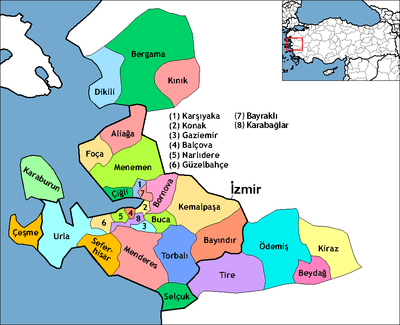Alaçatı
| Alaçatı | |
|---|---|
| Town | |
|
A street in Alaçatı | |
 Location of Alaçatı within Turkey. | |
| Country |
|
| Region | Aegean |
| Province | İzmir |
| Elevation | 16 m (52 ft) |
| Time zone | EET (UTC+2) |
| • Summer (DST) | EEST (UTC+3) |
| Postal code | 35xxx |
| Area code(s) | (+90) 232 |
| Licence plate | 35 |
| Website | www.alacati.bel.tr |
Alaçatı (also known as Alatsata, from Greek "Αλάτσατα") is an Aegean town on the western coast of İzmir Province in Turkey, which has been famous for its architecture, vineyards and windmills for over 150 years. It has now made its name in the world of windsurfing and kitesurfing, with its crystal clear water, consistent and steady wind and well acclaimed hospitality. Alacati is one of the most authentic towns in Turkey with stone houses, narrow streets, boutique hotels and restaurants with tables on the streets. Alacati has a great nightlife, where the nightclubs by the seaside are open until morning. The area is also home to the Alacati yacht marina and the famous Port Alacati development, created by the French architect Francois Spoerry and his son, Yves Spoerry.[1]
Origin of the Name
There are numerous stories about the name Alaçatı. According to some, Alaçatı refers primarily to the harbour area which is about two kilometers from the old town. Some claim that the name for the town was Agrilia, and there is also another name Alaca At (Red Horse) used for the whole area. Their claim is based on a story, that the ruler of Alaçatı had a red horse to ride. When riding the horse, bystanders would refer to him as "Alacaatlı (the man with the red horse)", in time the name was somehow changed to Alaçatı. According to some Greek sources the name Alatsata comes from the Greek word alas (άλας) meaning salt. The region was named because of the nearby salt lakes.
During the exchange of populations between Greece and Turkey, Muslim refugees from Greece were settled here, and ever since then the name Alaçatı has been adopted both for the town and the harbour area. The harbour area was the export port of İzmir until World War II. After the war the harbour's use declined, and the bay, in which the harbour was, is now popular with windsurfers.
History
Alaçatı became an Ottoman town in the 14th century, according to some; in the 15th century, according to others. Regardless of the date, Alaçatı was originally settled by Greeks in the 17th century.[2] The Muslim population was 132 out of a population of 13,845 in 1895. After the defeat of the Ottomans in the Balkan Wars, Ottoman Muslim refugees fled to the western coast of Anatolia. The Greek population of Alaçatı was forced to leave in 1914 and the village was empted. Most of the Greek returned in 1919 during Greek administration of Smyrna (1919-1922) when the Hellenic Army occupied the region of Izmir. The majority fled hastily with the retreating Greek Army following Greece's defeat in the Greco-Turkish War, whilst others fled from the shores of Smyrna.[3][4] The unilateral emigration of the Greek population, already at an advanced stage, was transformed into a population exchange backed by international legal guarantees.[5]
Under the Treaty of Lausanne in 1923 and according to the implementation of the compulsory exchange of populations, Muslims who lived in Crete, Thrace, Macedonia and Dodecanese settled in Alatsata city in the houses abandoned by the Greeks. Most of these houses still remain in Alaçatı as an attraction for people to see and absorb the feeling of life in the past.
Architecture
Alacati has stone houses and narrow streets with pavements. The centre of Alacati only has old Greek houses which are over 100 years old. As the town was declared as a historical site in 2005, the buildings are well protected. The new houses built recently built closely are constructed by using exactly the same architecture.[6]
Culture
The experiences of novelist Mehmet Culum during his travels in the region inspired him to write Alaçatili, his second novel.
Toponyms
Several cities have been named after Alatsata, including Nea Alatsata, Crete; Nea Erythraia, Athens, Greece. A great number of Alatsatean refugees were settled in Greece, in Attica, Euboea, Crete, Chios, Lesvos, Samos, Thessaloniki and in Agrinion. Regions with settlements, bearing the name New Alatsata ("Νέα Αλάτσατα" in Greek) exist in the Municipality of Byron, in Athens, in Chalkis and in Heraklion of Crete. Besides Greece, Alatsateans migrated in almost all the continents but mostly in the U.S. of America, where in Somerville, in Boston the Small Alatsata was founded and in Australia.
Notable natives
- George Dilboy (1896–1918), American soldier of Ottoman-Greek descent
- Metropolitan Iakovos (Garmatis) of Chicago
- Çağla Kubat (born 1979), female windsurfer
See also
| Wikimedia Commons has media related to Alaçatı. |
| Wikivoyage has a travel guide for Alaçatı. |
Coordinates: 38°16′53″N 26°22′27″E / 38.2813889°N 26.3741667°E
References
- ↑ "Cesme Alacati Guide".
- ↑ "History of the city".
- ↑ Sofos, Spyros A.; Özkırımlı, Umut (2008). Tormented by History: Nationalism in Greece and Turkey. C Hurst & Co Publishers Ltd. pp. 116–117. ISBN 1-85065-899-4.
- ↑ Hershlag, Zvi Yehuda (1997). Introduction to the Modern Economic History of the Middle East. Brill Academic Pub. p. 177. ISBN 90-04-06061-8.
- ↑ Yosef Kats (1998). Partner to partition: the Jewish Agency's partition plan in the mandate era. Routledge. p. 88. ISBN 0-7146-4846-9.
- ↑ http://www.tasotel.com/en/explore-alacati/
Further reading
- Constantinos J. Garmatis; Marianna N. Mastrostamati (2007). After Alatsata. The Alatsateans worldwide. Association of the Alatsateans. ISBN 978-960-87159-1-2.
- Fanis N. Kleanthis (2003). Alatsata my lost homeland. Association of the Alatsateans.
- Constantinos A. Vlamos (1946). Alatsata of the Ionic or Erythrean Peninsula (1st ed.). Thessaloniki: Mich. Triantafyllou.